WEBSITE HIGHLIGHTS: FOR GUYS AND GALS
 The differences between men and women have been made famous by author, John Gray, in his book Men Are From Mars, Women Are From Venus. Over the many years we have been selling diamonds, we have observed the difference between Martians and Venusians never greater than when it comes to a diamond purchase.
The differences between men and women have been made famous by author, John Gray, in his book Men Are From Mars, Women Are From Venus. Over the many years we have been selling diamonds, we have observed the difference between Martians and Venusians never greater than when it comes to a diamond purchase.
Check out our For Guys Only and For Gals Only pages. Our clients give us lots of positive feedback on these pages and they have helped a lot of diamond shoppers avoid expensive mistakes.
DIAMOND SHOPPER MISTAKES: DO NOT ASSUME JEWELER IS DIAMOND EXPERT
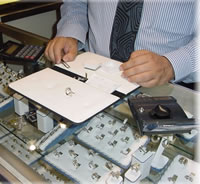 Believing that the person standing behind the counter in a jewelry store is a diamond expert is a mistake that we hear about almost every day. We are amazed by the stories we hear from diamonds shoppers concerning what jewelry store employees and owners have told them about diamonds.
Believing that the person standing behind the counter in a jewelry store is a diamond expert is a mistake that we hear about almost every day. We are amazed by the stories we hear from diamonds shoppers concerning what jewelry store employees and owners have told them about diamonds.
Keep in mind that a jewelry store employee or owner has a store full of jewelry and gifts so diamonds are a small part of their business. Seldom is the person you are talking to in a jewelry store, the same person who buys the diamonds. They are often tag readers who are trained on how to read the descriptions and prices from the little tag attached to the item.
The lack of knowledge and training in diamonds becomes even more dangerous when it combined with the bias to sell what they have in inventory. If you bring a diamond into the store that you are considering buying and ask for an opinion, the jewelry store employee has every incentive to talk down the diamond you have in hopes of selling you something from their display case.
They make up stories to sell their inventory. For example, we heard a story last week about a lady who bought what she thought was a very rare blue diamond from a high end jewelry store. Since blue diamonds with the carat weight she purchased would cost hundreds of thousands of dollars, it was apparent to us that the diamond simply had strong blue fluorescence. Instead of telling their customer that the strong fluorescence was a negative and should result in a lower price, they told her it was rare and sold it a premium price.
Do all jewelry store employees and owners exaggerate and bend the truth? Of course not, but the only way to protect yourself is to do your own research so you can make knowledgeable and informed decisions.
DIAMOND PRICES UPDATE
The Diamond Trading Co. (DTC) announced in early June that it would raise rough prices by just under 3 percent, effective from the June sight.
 The increase follows a strong first quarter in pivotal consumer markets, and is based on projections of continued consumer conference throughout the rest of 2005, DTC said in a release. The size of the increase will vary from one sightholder to the next, with more sizable increases focused on categories where there is the strongest demand for polished diamonds. Our discussions with diamond cutters indicate that the bigger carat weights and higher color and clarity stones have price increases well over 3 percent.
The increase follows a strong first quarter in pivotal consumer markets, and is based on projections of continued consumer conference throughout the rest of 2005, DTC said in a release. The size of the increase will vary from one sightholder to the next, with more sizable increases focused on categories where there is the strongest demand for polished diamonds. Our discussions with diamond cutters indicate that the bigger carat weights and higher color and clarity stones have price increases well over 3 percent.
De Beers’ marketing arm, the Diamond Trading Co., reported rough sales amounting to $5.695 billion last year, up 3 percent over 2003 sales amid multiple price hikes on rough. In 2004, rough prices averaged 14 percent higher than in 2003, though polished prices have lagged several percentage points behind.
INCLUSIONS & BLEMISHES: CHIPS AND CAVITIES
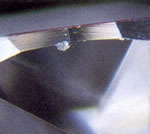 A chip is a shallow opening on the surface that typically has a rounded outline. A chip is the result of damage that occurs after cutting and polishing so it will not be accompanied by drag lines. A nick is a small chip, usually on the girdle and can be caused by wear. Sometimes a nick or chip can be seen on the edge of a facet.
A chip is a shallow opening on the surface that typically has a rounded outline. A chip is the result of damage that occurs after cutting and polishing so it will not be accompanied by drag lines. A nick is a small chip, usually on the girdle and can be caused by wear. Sometimes a nick or chip can be seen on the edge of a facet.
The odds of chipping your diamond during every day wear are quite slim, but it is something you should be aware of so that you can take proper precautions. Reduce your chances of damaging your diamond by using common sense. Avoid wearing it while participating in sports activities, gardening, rigorous housework, packing, moving, etc.
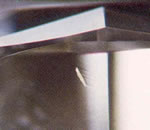 A cavity is the space left when a surface-reaching crystal drops out or is forced out during polishing. It can also result when part of a feather breaks away and leaves a deep, angular opening. A cavity is usually distinguishable from a chip in that it usually has drag lines visible to one side of the cavity where minute diamond particles are dragged across the diamond surface by the polishing wheel.
A cavity is the space left when a surface-reaching crystal drops out or is forced out during polishing. It can also result when part of a feather breaks away and leaves a deep, angular opening. A cavity is usually distinguishable from a chip in that it usually has drag lines visible to one side of the cavity where minute diamond particles are dragged across the diamond surface by the polishing wheel.
CHINA INCREASES SHARE OF DIAMOND POLISHING MARKET
India excels at polishing diamonds as tiny as a hundredth of a carat. Masters of this craft in Antwerp and in Tel Aviv excel at handling diamonds of a carat or more.
But pushing into the broad middle as the newest diamond power is China, a nation long enamored of jade that ignored the stones for much of its half century of communist rule.
The past is no longer holding it back. Several dozen privately owned foreign companies, most of them very secretive, have set up diamond polishing and jewelry manufacturing operations in China, many based here in a city about 129 kilometers, or 80 miles, up the Pearl River from Hong Kong. With a potent mix of experience, cheap labor, advanced technology and strict quality controls, they are challenging the industry leaders, especially India.
 China now imports $800 million a year worth of rough diamonds and polishes them to become worth roughly $1.1 billion, accounting for 6 percent of the value added by the world’s $4.6 billion diamond polishing industry.
China now imports $800 million a year worth of rough diamonds and polishes them to become worth roughly $1.1 billion, accounting for 6 percent of the value added by the world’s $4.6 billion diamond polishing industry.
India, with a million diamond workers and an 80 percent share of the diamond polishing business, is nervous. Alarmed by the pace and skill with which China is improving, India’s diamond industry leaders say that in diamonds, as in so many other businesses, China’s advance cannot be stopped.
What this competition means for the consumer is high quality cutting for lower prices. There is more competition in all aspects of the diamond supply chain than ever before and the diamond buying public is the big winner. That does not mean diamond prices are going down because that is more dependent on the supply of mined rough diamonds but it does mean there is less mark up on services in the rest of the cutting, polishing, wholesale distribution and retailing of diamonds.
GEMSTONES: GARNET
 The gemstone Garnet is the official birthstone for January as adopted by the American National Association of Jewelers in 1912. Garnets range from a 7.0 to 7.5 on the Mohs scale of hardness and are found in the U.S. (Arizona), South Africa, Argentina, Australia, Brazil, Myanmar (Burma), Scotland, Switzerland and Tanzania.
The gemstone Garnet is the official birthstone for January as adopted by the American National Association of Jewelers in 1912. Garnets range from a 7.0 to 7.5 on the Mohs scale of hardness and are found in the U.S. (Arizona), South Africa, Argentina, Australia, Brazil, Myanmar (Burma), Scotland, Switzerland and Tanzania.
According to folklore and legend, garnet’s powers include healing, strength, and protection and it is often worn to relieve inflammations of the skin. It is also believed to regulate the heart and blood flow and aid in curing depression. In earlier times, garnets were exchanged as gifts between friends to demonstrate their affection for each other and to insure that they meet again.
Garnets are often thought of as dark red gems. Garnets, however, have a great color variation, and gems of all colors (except blue) are cut from them. Garnet is not a single mineral, but a group of minerals closely related in physical and chemical properties. The individual minerals of the garnet group are called “garnets” The six types of garnet used as gems are Pyrope, Almandine, Spessartine, Grossular, Andradite and Uvarovite.
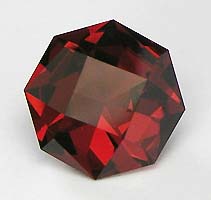 Pyrope is the most famous form of garnet. Its dark, blood-red color is distinct and attractive. Pyrope gemstones are often totally clean of inclusions. A rose-red to violet variety, known as rhodolite, is also a popular gem. Rhodolite is not a pure variety of pyrope, but a mixture of pyrope and almandine.
Pyrope is the most famous form of garnet. Its dark, blood-red color is distinct and attractive. Pyrope gemstones are often totally clean of inclusions. A rose-red to violet variety, known as rhodolite, is also a popular gem. Rhodolite is not a pure variety of pyrope, but a mixture of pyrope and almandine.
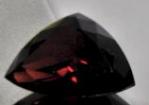 Almandine is the most common garnet, and the most widely used garnet gem. It is usually black and opaque, but lighter colored stones are occasionally found. Most almandine is too dark to use as a gem. The underside of some gems are hollowed out to let more light enter the stone, thus giving the gem a lighter color. If the bottom of the garnet is covered by a jewelry setting, the only way to easily determine if the garnet is hollow is by its lighter weight. Almandine garnets are usually faceted with the brilliant cut, which fully displays the fiery red color of this gem.
Almandine is the most common garnet, and the most widely used garnet gem. It is usually black and opaque, but lighter colored stones are occasionally found. Most almandine is too dark to use as a gem. The underside of some gems are hollowed out to let more light enter the stone, thus giving the gem a lighter color. If the bottom of the garnet is covered by a jewelry setting, the only way to easily determine if the garnet is hollow is by its lighter weight. Almandine garnets are usually faceted with the brilliant cut, which fully displays the fiery red color of this gem.
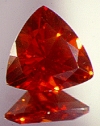 Natural spessartine has an orange color, but iron impurities are usually present, giving it a reddish or brownish color. Spessartine itself is not a common garnet, and is usually not found as transparent, gem quality material. Orange, pink, and brownish-red gems and cabochons are cut from this garnet. Spessartine is one of the lesser-known garnets, as it does not have any superior attributes over the other garnets (and it is rather uncommon).
Natural spessartine has an orange color, but iron impurities are usually present, giving it a reddish or brownish color. Spessartine itself is not a common garnet, and is usually not found as transparent, gem quality material. Orange, pink, and brownish-red gems and cabochons are cut from this garnet. Spessartine is one of the lesser-known garnets, as it does not have any superior attributes over the other garnets (and it is rather uncommon).
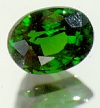 Grossular is the most varicolored garnets. Pure grossular, without any impurities, is colorless; the wide range of colors in this garnet is caused by various impurities. Grossular garnet is cut into various gems, with the varieties hessonite (orange) and tsavorite (green) being the most popular. The pink form of this gem is occasionally cut into gems, but all other colors are rarely used.
Grossular is the most varicolored garnets. Pure grossular, without any impurities, is colorless; the wide range of colors in this garnet is caused by various impurities. Grossular garnet is cut into various gems, with the varieties hessonite (orange) and tsavorite (green) being the most popular. The pink form of this gem is occasionally cut into gems, but all other colors are rarely used.
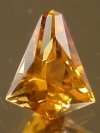 Andradite is the most lustrous of all garnets, and its dispersion (“fire”) exceeds even that of diamond. There are three gem varieties of andradite: Demantoid (emerald-green to green variety), Topazolite (yellow variety) and Melanite (lustrous, opaque black or dark red variety). The demantoid variety, which is remarkably rare, is the most valuable form of garnet. The combination of its color and fire give it unsurpassed splendor. Demantoid is easily identified by its characteristic “horsetail” inclusions. Demantoid was very popular in the 19th century, but its popularity has decreased because of its rarity and softness. The topazolite variety rarely occurs in crystals large enough to be worth faceting, and is thus rarely seen in jewelry. The melanite variety was once used in mourning jewelry, but does not have any gem use nowadays.
Andradite is the most lustrous of all garnets, and its dispersion (“fire”) exceeds even that of diamond. There are three gem varieties of andradite: Demantoid (emerald-green to green variety), Topazolite (yellow variety) and Melanite (lustrous, opaque black or dark red variety). The demantoid variety, which is remarkably rare, is the most valuable form of garnet. The combination of its color and fire give it unsurpassed splendor. Demantoid is easily identified by its characteristic “horsetail” inclusions. Demantoid was very popular in the 19th century, but its popularity has decreased because of its rarity and softness. The topazolite variety rarely occurs in crystals large enough to be worth faceting, and is thus rarely seen in jewelry. The melanite variety was once used in mourning jewelry, but does not have any gem use nowadays.
Uvarovite is the rarest of the familiar garnets, and is seldom used as a gem. It only occurs in very small crystals, and a crystal large enough for faceting is usually preserved as a mineral specimen. This garnet is only occasionally faceted for collectors into gems.
